What Is Biological Inheritance?

Our body is made up of cells, which are considered the basic unit of life. Humans have eukaryotic cells, and it is within an area of these, called the nucleus, where most of our DNA is protected and compacted. Find out all about biological inheritance today!
The human genome: the basis of biological inheritance
The DNA of human beings contains the genetic information of each person, which is divided into genes, which are expressed to make up the individual person. Normally, people have two copies of each gene, one from the biological mother and one from the biological father.
When a cell is about to divide, the genetic material is condensed and organized into chromosomes. Humans have 46 chromosomes, arranged in pairs, which are called homologous chromosomes and share the same information. One of them has been inherited from the mother and the other from the father.
Also, male and female chromosomes differ in a pair of chromosomes which are the sex chromosomes, X and Y, and determine sex.

You may be interested in: Contraceptives and High Blood Pressure: How Are They Related?
What is the origin of hereditary diseases
Human genetics studies the biological inheritance of human beings, that is, how information is transmitted through generations.
As we have discussed, we have two copies of each gene, one that comes from the mother and the other from the father. Each of them has a function. Sometimes, variations or mutations can occur, which are small changes that can alter their normal functioning or even trigger a disease.
When one of these mutations occurs, it can be passed on to offspring as a mechanism of biological inheritance. That’s why a disease due to a change in a gene can also be inherited from generation to generation. But it doesn’t always have to be this way, since genetic expression doesn’t depend only on genes, but also on the environment.
How do disease-causing mutations manifest?
Mendelian genetics studies how genes are passed from generation to generation. It’s named after the father of genetics, Gregor Mendel, who first described the mechanisms of inheritance, or the so-called Mendel’s Laws. They describe how a mutation in a gene is passed from generation to generation.
Mutations can be dominant or recessive:
- Dominant mutations: These only need one copy to contain them to express themselves. This means that the person who inherits this mutation will develop the disease. This usually appears in all generations of a family and usually one of the parents is affected.
- Recessive mutations: In this case, two copies of the mutation are necessary for the disease to be triggered. Normally, the parents are carriers of the mutated gene and it’s one of the children who suffers from the disease. Carriers are individuals who have an affected gene, but don’t have the disease.
Read also: What Is Crohn’s Disease?
Hereditary patterns of disease

1. Autosomal dominant
Normally, one of the parents of the diseased person is usually affected as well. In addition, it tends to appear in all generations and the probability that an affected individual transmits the trait to each child is usually 50%. In this case, women and men are affected in the same way and can transmit it in the same way as well.
Some diseases that have this inheritance pattern are:
- Huntington’s disease
- Familial hypercholesterolemia
- Achondroplasia
- Neurofibromatosis type I
- Hemoglobinopathies
- Some diseases related to collagen, such as Osteogenesis imperfecta or Ehlers-Danlos
- Familial hypertrophic cardiomyopathies
2. Autosomal recessive
Autosomal recessive inheritance is one in which both copies of the same altered gene are needed. That is why both parents of the affected person are carriers.
In this case, it’s more difficult for all generations to be affected. But, equally, it’s transmitted to both sexes (sons and daughters) equally, with a probability normally of 25%. Remember that carriers don’t have to present any type of symptoms; in fact, they’re often unaware that they’re carriers.
Some diseases with this inheritance pattern are:
- Cystic fibrosis
- Spinal muscular atrophy
- Phenylketonuria
- Smith-Lemli-Opitz syndrome
- Sickle cell anemia
3. Sex-linked (X-linked)
In this case, the affected gene is located in one of the X or Y sex chromosomes. Remembering that women have two copies of the X chromosome (XX) and men, one copy of the X chromosome and one of the Y chromosome (XY), the pattern between both sexes in this case will be different.
Depending on whether the mutation is dominant or recessive, it will take a copy or two of the affected gene, respectively, for the next generation to suffer from the disease.
In this case, it should be noted that a father can’t transmit the disease to his male children, since, in this case, the father always contributes his Y chromosome. However, he can transmit it to his daughters, because, in this case, he gives them a copy of its X chromosome. When the mother is the one with an affected gene, she can pass it on to both sons and daughters.
Some X-linked diseases are:
- Duchenne muscular dystrophy
- Hypophosphatemic rickets
- Hemophilia A
- Fragile X syndrome
These are some of the inherited patterns, but there are other more complicated ones, as well as variants of them.
Our body is made up of cells, which are considered the basic unit of life. Humans have eukaryotic cells, and it is within an area of these, called the nucleus, where most of our DNA is protected and compacted. Find out all about biological inheritance today!
The human genome: the basis of biological inheritance
The DNA of human beings contains the genetic information of each person, which is divided into genes, which are expressed to make up the individual person. Normally, people have two copies of each gene, one from the biological mother and one from the biological father.
When a cell is about to divide, the genetic material is condensed and organized into chromosomes. Humans have 46 chromosomes, arranged in pairs, which are called homologous chromosomes and share the same information. One of them has been inherited from the mother and the other from the father.
Also, male and female chromosomes differ in a pair of chromosomes which are the sex chromosomes, X and Y, and determine sex.

You may be interested in: Contraceptives and High Blood Pressure: How Are They Related?
What is the origin of hereditary diseases
Human genetics studies the biological inheritance of human beings, that is, how information is transmitted through generations.
As we have discussed, we have two copies of each gene, one that comes from the mother and the other from the father. Each of them has a function. Sometimes, variations or mutations can occur, which are small changes that can alter their normal functioning or even trigger a disease.
When one of these mutations occurs, it can be passed on to offspring as a mechanism of biological inheritance. That’s why a disease due to a change in a gene can also be inherited from generation to generation. But it doesn’t always have to be this way, since genetic expression doesn’t depend only on genes, but also on the environment.
How do disease-causing mutations manifest?
Mendelian genetics studies how genes are passed from generation to generation. It’s named after the father of genetics, Gregor Mendel, who first described the mechanisms of inheritance, or the so-called Mendel’s Laws. They describe how a mutation in a gene is passed from generation to generation.
Mutations can be dominant or recessive:
- Dominant mutations: These only need one copy to contain them to express themselves. This means that the person who inherits this mutation will develop the disease. This usually appears in all generations of a family and usually one of the parents is affected.
- Recessive mutations: In this case, two copies of the mutation are necessary for the disease to be triggered. Normally, the parents are carriers of the mutated gene and it’s one of the children who suffers from the disease. Carriers are individuals who have an affected gene, but don’t have the disease.
Read also: What Is Crohn’s Disease?
Hereditary patterns of disease

1. Autosomal dominant
Normally, one of the parents of the diseased person is usually affected as well. In addition, it tends to appear in all generations and the probability that an affected individual transmits the trait to each child is usually 50%. In this case, women and men are affected in the same way and can transmit it in the same way as well.
Some diseases that have this inheritance pattern are:
- Huntington’s disease
- Familial hypercholesterolemia
- Achondroplasia
- Neurofibromatosis type I
- Hemoglobinopathies
- Some diseases related to collagen, such as Osteogenesis imperfecta or Ehlers-Danlos
- Familial hypertrophic cardiomyopathies
2. Autosomal recessive
Autosomal recessive inheritance is one in which both copies of the same altered gene are needed. That is why both parents of the affected person are carriers.
In this case, it’s more difficult for all generations to be affected. But, equally, it’s transmitted to both sexes (sons and daughters) equally, with a probability normally of 25%. Remember that carriers don’t have to present any type of symptoms; in fact, they’re often unaware that they’re carriers.
Some diseases with this inheritance pattern are:
- Cystic fibrosis
- Spinal muscular atrophy
- Phenylketonuria
- Smith-Lemli-Opitz syndrome
- Sickle cell anemia
3. Sex-linked (X-linked)
In this case, the affected gene is located in one of the X or Y sex chromosomes. Remembering that women have two copies of the X chromosome (XX) and men, one copy of the X chromosome and one of the Y chromosome (XY), the pattern between both sexes in this case will be different.
Depending on whether the mutation is dominant or recessive, it will take a copy or two of the affected gene, respectively, for the next generation to suffer from the disease.
In this case, it should be noted that a father can’t transmit the disease to his male children, since, in this case, the father always contributes his Y chromosome. However, he can transmit it to his daughters, because, in this case, he gives them a copy of its X chromosome. When the mother is the one with an affected gene, she can pass it on to both sons and daughters.
Some X-linked diseases are:
- Duchenne muscular dystrophy
- Hypophosphatemic rickets
- Hemophilia A
- Fragile X syndrome
These are some of the inherited patterns, but there are other more complicated ones, as well as variants of them.
- Alliance G. Cómo entender la genética: una guía para pacientes y profesionales médicos en la región de Nueva York y el Atlántico Medio. Genet Alliance. 2009;1–112.
- Copelli SB. Genética Desde la herencia a la manipulación de los genes [Internet]. 2010. 1-94 p. Available from: http://www.fundacionazara.org.ar/img/libros/genetica.pdf
- Urbano A, Montoya E, Ochando I, Sánchez M, Rueda J. Ventajas del cribado de portadores en donantes de gametos con un panel de 15 genes mediante tecnología Next ‐ Generation Sequencing. Genética Médica Y Genómica. 2018;2:21–9.
Este texto se ofrece únicamente con propósitos informativos y no reemplaza la consulta con un profesional. Ante dudas, consulta a tu especialista.







